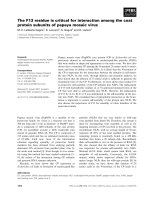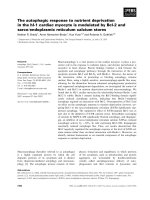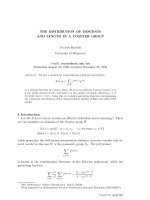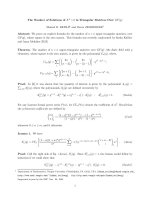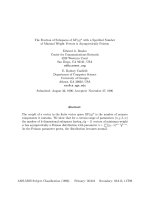Báo cáo toán học: "The t-pebbling number is eventually linear in t " pptx
Bạn đang xem bản rút gọn của tài liệu. Xem và tải ngay bản đầy đủ của tài liệu tại đây (85.8 KB, 4 trang )
The t-pebbling number is eventually linear in t
Michael Hoffmann
ETH Z¨urich, Switzerland
Jiˇr´ı Matouˇsek
Charles University, Prague, Czech Republic
Yoshio Okamoto
∗
JAIST, Nomi, Japan
Philipp Zumstein
ETH Z¨urich, Switzerland
Submitted: Apr 4, 2010; Accepted: J un 22, 2011; Published: Jul 22, 2011
Mathematics Subject Classification: 05C99, 05C35
Abstract
In graph pebbling games, one considers a distribution of pebbles on the vertices
of a graph, and a pebbling move consists of taking two pebbles off one vertex and
placing one on an adjacent vertex. The t-pebbling number π
t
(G) of a graph G is the
smallest m such that for every initial distribution of m pebbles on V (G) and every
target vertex x there exists a sequence of pebbling moves leading to a distibution
with at least t pebbles at x. Answering a question of Sieben, we show that for every
graph G, π
t
(G) is eventually linear in t; that is, there are numbers a, b, t
0
such that
π
t
(G) = at + b for all t ≥ t
0
. Our result is also valid for weighted graphs, w here
every edge e = {u, v} has some integer weight ω(e) ≥ 2, and a pebbling move from
u to v removes ω(e) pebbles at u and adds one pebble to v.
1 Introduction
Let G = (V, E) be an undirected graph. A pebbling distribution on G is a function
p: V → N
0
= {0, 1, 2, . . .}. A pebbling move consists of taking two pebbles off a vertex u
and adding one pebble on an adjacent vertex v (we can think of this a s paying a toll of
one pebble for using the edge {u, v}). We also say that we move one pebble from u to v.
More generally, we consider a graph G together with a weight function ω : E →
{2, 3, 4, . . .} on edges. If an edge e = {u, v} has weight ω(e), then we pay a toll of
∗
Supported by Global COE P rogram “Computationism as a Foundation for the Sciences” and Grant-
in-Aid for Scientific Research from Ministry of Education, Science and Culture, Japan, and Japan Society
for the Promotion of Science.
the electronic journal of combinatorics 18 (2011), #P153 1
ω(e) − 1 pebbles for moving one pebble along e. (So the unweighted case corresponds to
ω(v) = 2 for all v ∈ V (G).)
More formally, if e = {u, v} ∈ E and p is a pebbling distribution such that p(u) ≥ ω(e),
then a pebbling move allows us to replace p with the distriution p
′
given by
p
′
(w) =
p(u) − ω(e) for w = u,
p(v) + 1 for w = v,
p(w) otherwise.
For a vertex x ∈ V (G), let π
t
(G, ω, x) be the smallest integer m such for all dis-
tributions p of m pebbles there is a distribution q with q(x) ≥ t that can be reached
from p by a sequence of pebbling moves. The t-pebbling number of (G, ω) is defined as
π
t
(G, ω) = max{π
t
(G, ω, x) : x ∈ V (G)} and we write π
t
(G) for the unweighted case with
ω ≡ 2.
Graph pebbling originated in combinatorial number theory and group theory. The
pebbling game (unweighted and with t = 1) was suggested by Lagarias and Saks, and in
print it first appears in Chung [2]. For more background we refer to two recent surveys
by Hurlbert [4, 5 ].
For some graph classes the (unweighted) t-pebbling number has been determined
exactly. We have π
t
(K
n
) = 2t + n − 2 for the complete graph, π
t
(C
2n
) = t2
n
and
π
t
(C
2n−1
) = t2
n−1
+ 2⌊
2
n
3
⌋ − 2
n−1
+ 1 for the cycle, a nd π
t
(Q
d
) = t2
d
for the cube (see
[7]). All o f these are linear functions of t. Moreover, one can show that the t-pebbling
number of any tree is linear in t by using the methods of [8]. It is shown in [6] that for
the complete bipartite graph, we have π
t
(K
m,n
) = max{2t + m +n −2, 4t +m − 2}, which
is linear in t but only for t sufficiently large.
Sieb en [8] asked whether the t-pebbling number is always linear for t ≥ t
0
where t
0
is some constant. We answer this question affirmatively. A similar result is known in
Ramsey theory: the Ramsey number of t copies of a graph G is eventually linear in t
(see [1]).
To formulate our result, let us define, for every two vertices u, v ∈ V (G), the multi-
plicative distance
mdist(u, v) := min
e∈E(P )
ω(e) : P is a u-v-path in G
,
(in particular, mdist(u, u) = 1 because the empty product equals 1). The function
log(mdist(u, v)) clearly defines a metric on V (G). Further, fo r x ∈ V (G) we set
r
x
:= max{mdist(x, v) : v ∈ V (G)}.
Theorem 1. For every graph G with edge weight function ω and for every x ∈ V (G)
there exist b and t
0
such that that for all t ≥ t
0
π
t
(G, ω, x) = r
x
t + b.
Consequently, for a suitable t
0
= t
0
(G, ω), π
t
(G, ω) is a linear function of t for all t ≥ t
0
.
the electronic journal of combinatorics 18 (2011), #P153 2
As a corollary, we immediately obtain a result from Hersovici et al. [3] about fractional
pebbling:
lim
t→∞
π
t
(G)
t
= 2
diam(G)
,
where diam(G) denotes the diameter of G in the usual shortest-path metric. Indeed, fo r
the weight function ω ≡ 2 we have max
x∈V (G)
r
x
= 2
diam(G)
.
Unfortunately, our proof of Theorem 1 is existential, and it yields no upper bound on
t
0
. It would be interesting to find upper bounds on (the minimum necessary) t
0
in terms
of G and ω, or lower bounds showing that a large t
0
may sometimes be needed.
2 Proof of Theorem 1
First we check that
π
t
(G, ω, x) ≥ r
x
t (1)
for all t. To this end, we consider the distribution p
0
with r
x
t − 1 pebbles, all placed at a
vertex y with mdist(x, y) = r
x
. We claim that, starting with p
0
, it is impossible to obtain
t pebbles at x.
To check this, we define the potential of a pebbling distribution p as
F (p) :=
v∈V (G)
p(v)
mdist(v, x)
.
It is easy to see that this potential is nonincreasing under pebbling moves (using the
“multiplicative triangle inequality” mdist(u, x) ≤ ω({u, v})mdist(v, x)). Now F (p
0
) < t,
while any distribution q with at least t pebbles at x has F (q ) ≥ t, which proves the claim
and thus also (1).
Next, we define the function
f(t) := π
t
(G, ω, x) − r
x
t.
We have f (t) ≥ 0 for all t by (1). Let n := |V (G)|; we claim that f is nonincreasing for all
t ≥ n. Once we show this, Theorem 1 will be proved, since a nonincreasing nonnegative
function with integer values has to be eventually constant.
So we want to prove t hat , for all t ≥ n, we have f (t) ≤ f (t − 1), which we rewrite to
π
t
(G, ω, x) ≤ π
t−1
(G, ω, x) + r
x
. (2)
To this end, we consider an arbitrary pebbling distribution p with m := π
t−1
(G, ω, x)+
r
x
pebbles. By (1) we obtain m ≥ r
x
(t − 1) + r
x
= r
x
t ≥ r
x
n. So by the pigeonhole
principle, there exists a vertex y with p(y) ≥ r
x
.
Let us temporarily remove r
x
pebbles from y. This yields a distribution with at
least π
t−1
(G, ω, x) pebbles, and, by definition, we can convert it by pebbling moves to a
distribution with at least t − 1 pebbles at x. Now we add the r
x
pebbles back to y and
move them toward x, and in this way we obtain one additional pebble at x. This verifies
(2), and the proof of Theorem 1 is finished.
the electronic journal of combinatorics 18 (2011), #P153 3
References
[1] S. Burr, P. Erd˝os, J. Spencer. Ramsey theorems for multiple copies of graphs. Trans.
of the American Mathematical Society. 209 (1975) 87–99.
[2] F. R. K. Chung. Pebbling in hypercubes. SIAM J. Discrete Math. 2 (1989) 467–472.
[3] D. S. Hersovici, B. D. Hester, G. H. Hurlbert. Diameter bounds, fractional pebbling,
and pebbling with arbitrary target distributions. ArXiv preprint, http://arxiv.
org/abs/0905.3949.
[4] G. Hurlbert. A survey of graph pebbling. Congressus Numerantium 139 (1999) 41–64.
[5] G. Hurlbert. Recent progress in graph pebbling. Graph Theory Notes of New York
XLIX (2005) 25–37.
[6] A. Lourdusamy, A. Punitha. On t-pebbling graphs. Utilitas Math., to appear, 20 10.
[7] A. Lourdusamy and S. Somasundaram. The t-pebbling number of graphs. Southeast
Asian Bull. Math. 30 (2006) 907–914.
[8] N. Sieben. A graph pebbling alg orithm on weighted graphs. J. of Graph Algorithms
and Applications. 14 (2010) 221–244.
the electronic journal of combinatorics 18 (2011), #P153 4
